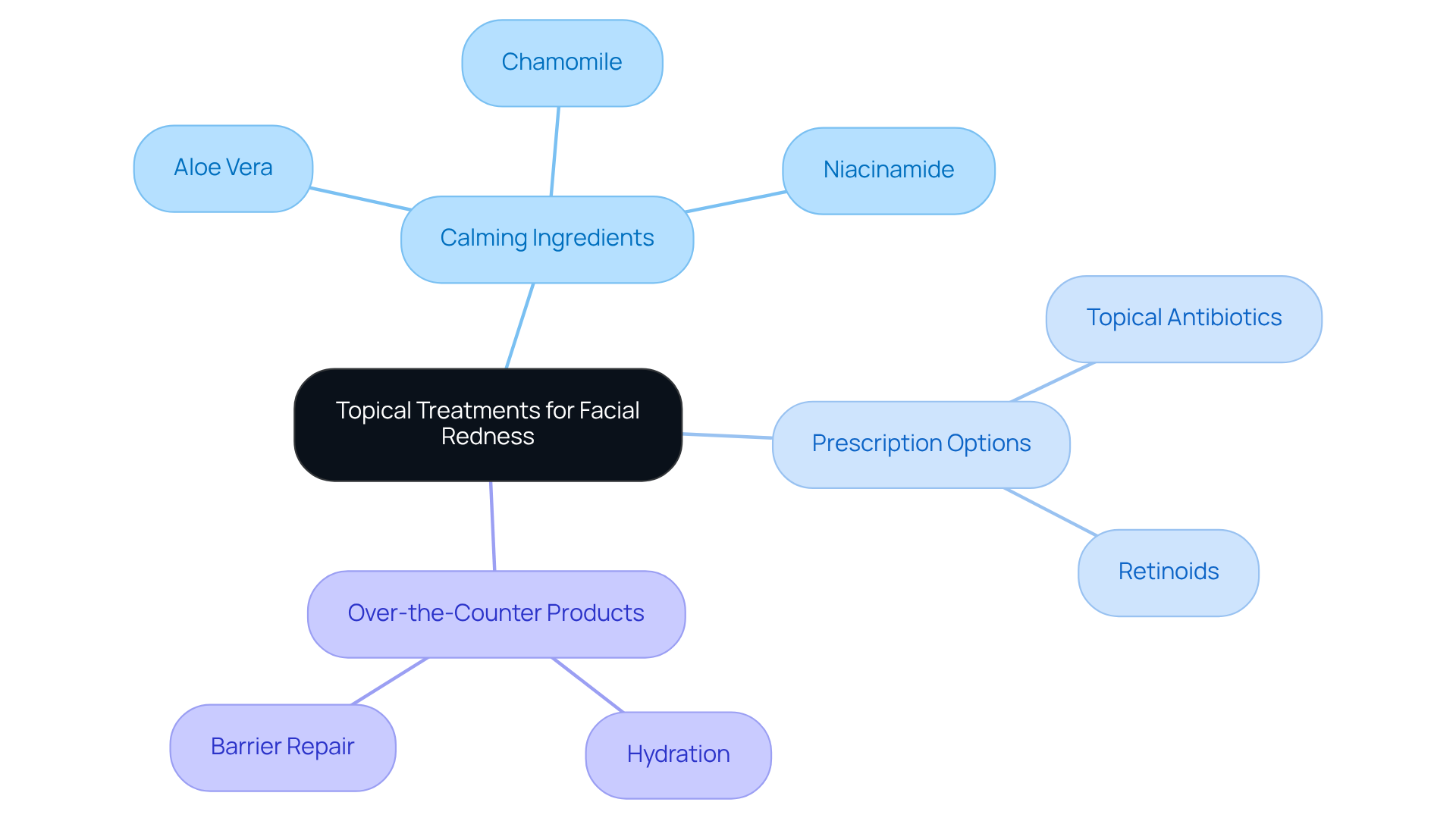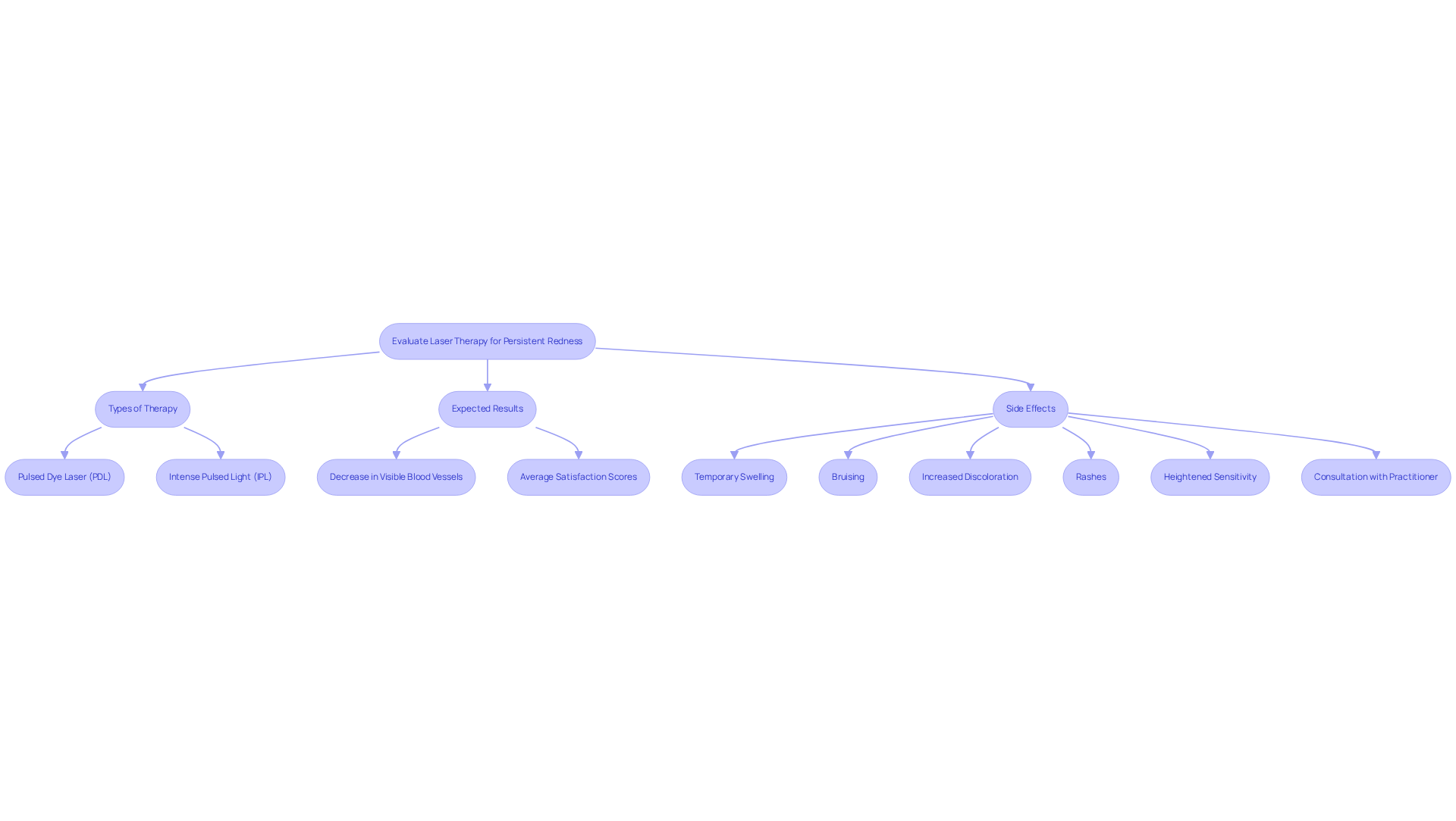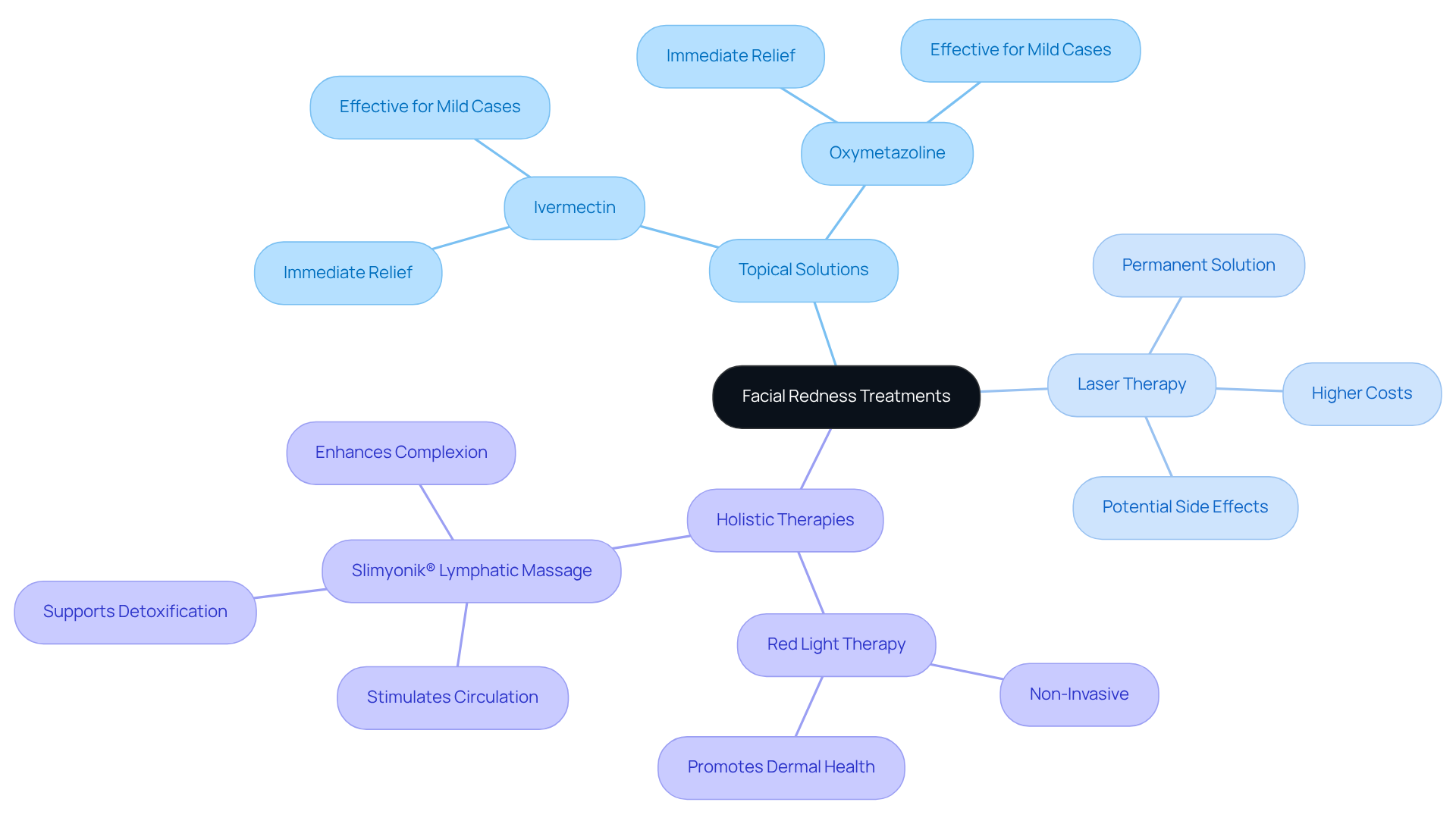Facial Redness Treatments: Compare Top Options for Relief

Overview
This article provides a comprehensive comparison of various treatments for facial redness, underscoring the necessity for personalized solutions tailored to the underlying causes, including conditions such as rosacea and environmental factors. By detailing treatment options like:
- Topical applications
- Laser therapy
- Holistic approaches
it highlights their effectiveness. Furthermore, it emphasizes the critical importance of consulting professionals to devise the most suitable strategy for individual skin needs. Such personalized care not only addresses the symptoms but also targets the root causes, ensuring long-lasting results.
Introduction
Facial redness is a condition that can cause significant distress for many individuals, often arising from various sources such as rosacea, allergies, or environmental factors. Understanding these underlying causes is essential for those seeking effective treatments, which can range from topical creams to advanced therapies like SQT Bio-Microneedling and laser options.
With an abundance of choices available, determining the most suitable approach for one’s unique skin needs becomes imperative. This article examines the leading treatments for facial redness, comparing their effectiveness and exploring holistic options, ultimately guiding readers toward achieving a calmer, healthier complexion.
Understanding the Causes of Facial Redness
Facial flushing can arise from various sources, with rosacea being one of the most prevalent. This chronic inflammatory skin condition affects approximately 5% of the global population, manifesting as flushing, visible blood vessels, and sometimes acne-like breakouts. Research indicates that women are three to four times more likely than men to develop rosacea, with the highest prevalence observed in adults aged 25 to 39 at 3.7%.
In addition to rosacea, allergic responses to skincare items or environmental irritants can lead to flushing. Factors such as excessive sun exposure, extreme temperatures, and lifestyle choices—including stress, alcohol consumption, and spicy foods—can further exacerbate the condition. A systematic review emphasizes that understanding these triggers is essential for selecting effective solutions, as different causes may require customized methods for optimal relief.
Dermatologists stress the importance of identifying specific triggers to manage symptoms effectively. For instance, a study found that 54% of individuals with rosacea experience fatigue, while 50% report difficulties sleeping, underscoring the condition's impact on overall quality of life.
A groundbreaking solution for addressing facial redness treatments and dermal congestion is SQT Bio-Microneedling, which employs Spongilla spicules. These spicules are rich in essential nutrients and minerals for the complexion and establish around 3-5 million micro channels within just 5 minutes of application. This innovative therapy stimulates collagen and elastin production, enhancing rejuvenation and improving the overall health of the dermis. The treatment significantly increases the absorption of topical products and promotes faster cell turnover. Unlike conventional techniques, SQT Bio-Microneedling is suitable for all complexions and has no adverse effects, making it a secure and efficient option for individuals looking for facial redness treatments related to rosacea and other dermal issues.
For those facing skin discoloration, a series of 4 sessions is recommended every 2 weeks for lasting and effective outcomes. SQT Bio-Microneedling at Tsavo Wellness offers a promising solution that not only addresses symptoms but also enhances the resilience of the dermis against environmental aggressors. By acknowledging the complex characteristics of facial discoloration and exploring innovative therapies such as SQT, individuals can more effectively evaluate their options and improve their dermal condition.

Exploring Topical Treatments for Facial Redness
Facial redness treatments through topical applications are essential for those seeking effective solutions. Creams and serums formulated with calming ingredients, such as aloe vera, chamomile, and niacinamide, are designed to reduce inflammation and soothe irritated skin. Prescription options, including topical antibiotics or retinoids, can effectively manage underlying conditions like rosacea, providing a comprehensive approach to treatment. Over-the-counter products often emphasize hydration and barrier repair, critical for maintaining the health of sensitive complexions.
While these therapies can deliver prompt relief, their efficacy varies depending on individual complexion types and the root causes of irritation. Regular use is crucial for sustaining results, and patch testing is highly recommended to prevent adverse reactions. By understanding and utilizing these treatments, individuals can achieve a calmer, healthier complexion. Take the necessary steps today to explore the right options for your skin's needs.

Evaluating Laser Therapy for Persistent Redness
Laser therapy emerges as a powerful solution for persistent facial discoloration, serving as one of the effective facial redness treatments, particularly in conditions such as rosacea and vascular lesions. With targeted approaches like pulsed dye laser (PDL) and intense pulsed light (IPL), these facial redness treatments specifically address blood vessels, resulting in a marked reduction in discoloration and an overall enhancement in skin tone. Research shows that patients typically require between two to eight sessions, spaced three to four weeks apart, to achieve optimal results. Clinical studies reveal that PDL can lead to a 50% to 75% decrease in visible blood vessels after just a few sessions, with many patients reporting satisfaction scores averaging 8.15 out of 10.
While these therapies offer significant advancements, it is crucial to consider potential side effects, including:
- Temporary swelling
- Bruising
- Increased discoloration
- Rashes
- Heightened sensitivity
Additionally, not every individual qualifies for laser treatments; hence, a thorough consultation with a qualified practitioner is essential to customize the approach to each patient’s unique needs. Practitioners stress the importance of effective communication regarding medical history and current medications to ensure the best outcomes with these advanced therapies. Engage with a professional today to explore how laser therapy can transform your skin health.

Integrating Holistic Therapies for Comprehensive Relief
Integrating holistic therapies provides a multifaceted approach to alleviating facial redness treatments, addressing both physical and emotional contributors. Mindfulness meditation and yoga stand out as particularly effective methods for reducing stress, a major trigger for flare-ups. Research indicates that mindfulness practices can significantly decrease stress levels, which correlates with improved dermatological conditions. Additionally, therapies such as lymphatic massage at Tsavo Wellness enhance circulation, promoting healing and rejuvenation of the epidermis. Our advanced lymphatic massage therapies are designed to activate your body’s natural detoxification abilities, further enhancing dermal wellness.
The NRS Expert Committee advocates for the inclusion of gentle cleansers and nonocclusive moisturizers as part of a comprehensive management strategy for rosacea. Nutritional support is equally vital; incorporating anti-inflammatory foods rich in omega-3 fatty acids and antioxidants can markedly improve skin health. Furthermore, avoiding personal triggers and making lifestyle adjustments are essential components of effectively managing skin flushing. By adopting this comprehensive approach, individuals can gain more control over skin irritation while simultaneously enhancing their overall wellbeing.

Comparative Summary of Facial Redness Treatments
The management of facial redness treatments encompasses a variety of techniques, each offering distinct benefits and considerations. Topical solutions such as ivermectin and oxymetazoline provide immediate relief and are particularly effective for mild cases. Notably, a significant proportion of patients aged 60 and over continue to depend on these first-line therapies, highlighting their ongoing importance. In contrast, laser therapy offers a more permanent solution for persistent redness, though it may involve higher costs and potential side effects. Research shows that patients often express satisfaction with their care plans, with many rating their experiences positively on a scale of 1 to 5.
Holistic therapies can further augment these treatments by addressing underlying lifestyle factors and fostering overall wellness. At Tsavo Wellness, we integrate therapies like red light therapy, which is non-invasive and promotes dermal health, alongside Slimyonik® lymphatic massage to support recovery and enhance complexion. The Slimyonik® lymphatic massage utilizes advanced technology to stimulate circulation and detoxification, potentially leading to reduced discoloration and improved skin vitality. Ultimately, the most effective facial redness treatments will depend on the individual's specific condition, preferences, and their response to various therapies. Consulting with a healthcare professional is essential to develop a personalized treatment plan that effectively addresses facial redness treatments and enhances overall wellbeing. Dr. Linda Stein Gold emphasizes that older patients should discuss newer therapeutic options with their doctors to ensure they receive the most effective care.

Conclusion
Addressing facial redness necessitates a thorough understanding of its causes and the diverse treatment options available. From chronic conditions like rosacea to temporary triggers such as environmental irritants and lifestyle choices, recognizing the underlying factors is essential for effective management. This article underscores innovative solutions, including SQT Bio-Microneedling and laser therapies, alongside topical treatments and holistic approaches, emphasizing the need for tailored strategies based on individual skin types and conditions.
Key insights reveal the importance of:
- Identifying personal triggers
- The efficacy of topical treatments rich in calming ingredients
- The transformative potential of laser therapies for persistent redness
Additionally, integrating holistic practices such as mindfulness and dietary adjustments can significantly enhance overall skin health and resilience against flare-ups. Each treatment option presents unique benefits, and understanding these empowers individuals to make informed decisions about their skincare regimen.
Ultimately, achieving relief from facial redness is a multifaceted journey that merges medical interventions with lifestyle changes. By consulting with healthcare professionals and exploring a range of therapies, individuals can discover a personalized approach to effectively manage their skin concerns. Embracing this comprehensive strategy not only addresses the symptoms of facial redness but also fosters a deeper connection to overall wellbeing and skin vitality.
Frequently Asked Questions
What is the most common cause of facial redness?
The most common cause of facial redness is rosacea, a chronic inflammatory skin condition that affects approximately 5% of the global population.
Who is most likely to develop rosacea?
Women are three to four times more likely than men to develop rosacea, with the highest prevalence observed in adults aged 25 to 39.
What other factors can contribute to facial flushing?
Other factors that can contribute to facial flushing include allergic responses to skincare products, environmental irritants, excessive sun exposure, extreme temperatures, stress, alcohol consumption, and spicy foods.
Why is it important to identify specific triggers for facial redness?
Identifying specific triggers is important for managing symptoms effectively, as different causes may require customized methods for optimal relief.
What innovative treatment is available for facial redness and dermal congestion?
SQT Bio-Microneedling is an innovative treatment that uses Spongilla spicules to stimulate collagen and elastin production, improve dermal health, and enhance the absorption of topical products.
How many sessions of SQT Bio-Microneedling are recommended for skin discoloration?
A series of 4 sessions every 2 weeks is recommended for lasting and effective outcomes in addressing skin discoloration.
What are some key ingredients to look for in topical treatments for facial redness?
Key ingredients to look for in topical treatments include aloe vera, chamomile, and niacinamide, which are designed to reduce inflammation and soothe irritated skin.
What types of topical treatments are available for managing rosacea?
Topical treatments for managing rosacea can include prescription options like topical antibiotics or retinoids, as well as over-the-counter products that focus on hydration and barrier repair.
How can individuals ensure the effectiveness of topical treatments for facial redness?
Regular use of topical treatments is crucial for sustaining results, and patch testing is highly recommended to prevent adverse reactions.


